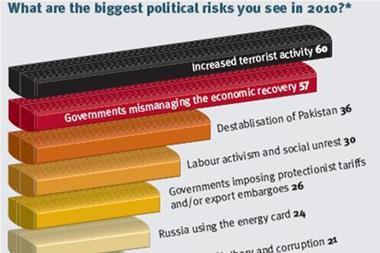18 countries downgraded in this year’s political risks map
Political and financial instability remain a feature of the business landscape as a result of the recession, according to Aon’s Political Risk Map.
Miles Johnstone, director of Aon’s Political Risk team, explained: "Rising risk levels in 2009 have led to a significant volume of credit and political risk claims in international insurance markets which is driving many of the 18 downgrades in this year's map. For instance non-payment of sovereign and sub-sovereign debt obligations is a major issue for underwriters insuring risks in Ghana, and underwriters continue to experience a multitude of claims stemming from payment defaults by private sector banks in Ukraine."
Food & Water Insecurity
The 2010 map introduces new indices looking at food, agricultural commodity and water supplies.
Sam Wilkin, associate director of the consultancy practice at Oxford Analytica, explains: “For the past 20 years, global population growth has outpaced growth in agricultural output. A run up in world food prices in 2007 and 2008 led to dramatic geopolitical events, from food riots in India to worker unrest in Cambodia. Last month the Food and Agriculture Organisation of the United Nations warned that global food prices could quickly rise again.
“With global warming changing regional climates and weather patterns and driving demand for bio-fuels, the world faces unprecedented food and water risks. Aon and Oxford Analytica have developed a pair of forward looking indices analysing global food and water insecurity.”
There are two new icons on the 2010 map: Food and Water Insecurity. They have been applied to the 30 most ‘high risk’ countries - that is those countries potentially facing the most severe food and water insecurity in the medium to long term. These are all developing countries, mostly in Africa, which is in keeping with the conventional wisdom that the impacts of climate change will rebound hardest on the countries least responsible for global warming.
Global Agricultural Commodity Supply
The Agricultural Commodity Supply Risk Index offers a supply-side view, identifying the internationally-traded agricultural commodities at greatest risk of a supply shock -- and thus a sudden global price spike.
Many of the world’s most productive agricultural regions are expected to see a decline in productivity if temperatures rise.
“Cocoa tops the 2010 Agricultural Commodity Supply Risk Index by some margin, as more than 75 percent of global production is concentrated in four countries at significant risk of supply disruption,” said Wilkin. “These threats to cocoa supplies include political instability, natural disaster, and water supply insecurity.”
Now and Then
The Food and Water Insecurity Indices are not meant to be alarmist, according to Roger Schwartz, senior vice president of Aon Trade Credit. “They are forward looking assessments designed to be an ‘early warning’. While the increasing supply-side pressures of Global Warming are more of a long-term issue, there are more immediate concerns.
“We are already seeing instances of countries that can’t produce enough of certain foods and in these financially difficult times can not afford to import these food supplies. This places localised pressures on a country’s social balance and can lead to the sort of geopolitical events we saw in 2007/8.
“With the prospect of real economic recovery over the next year or so, we are likely to see increased demand for food and water globally. With current supply-side issues being experienced in some areas, this will only add to the existing pressures.”
Movements on the 2010 Map
Nine countries have been upgraded to a lower risk level: Albania, Myanmar/Burma, Hong Kong, Colombia, South Africa, Sri Lanka, East Timor, Vanuatu and Vietnam.
Eighteen countries have seen conditions worsen leading to a downgrade: Algeria, Argentina, El Salvador, Equatorial Guinea, Ghana, Honduras, Kazakhstan, Latvia, Madagascar, Mauritania, Philippines, Puerto Rico, Seychelles, Sudan, United Arab Emirates, Ukraine, Venezuela and Yemen.
Sudan, Venezuela and Yemen have been added to the Very High category, joining Afghanistan, Congo DRC, Iran, Iraq, North Korea, Somalia and Zimbabwe.
Miles Johnstone concluded: “Aon believes 2010 will see elevated political risk levels continue before an overall tendency for improving global business conditions becomes established. For many companies and across different sectors, including credit and political risk insurance, the business environment remains uncertain when trading with or investing in politically or economically unstable countries.
“With a global business landscape that continues to shift and change, our interactive Political Risk Map provides our clients with up-to-date and relevant tools to assess the various contingencies and determine the impact on their ability to ensure continued survival, growth and profitability.”



















